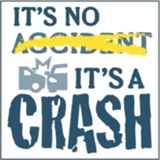
The Story Presented to the Public
During the July, 15, 2025 Cottonwood Heights City Council meeting, CHPD presented a chart showing the number of crashes for the month of June for the years of 2023, 2024, and 2025. During this presentation the following exchange between our Mayor and Chief of Police was enlightening:
[Ms. Terry] Here's our crashes for June of 2023, 2024, and 2025. As you can see, crashes are down for the last couple of years.
[Mayor Weichers] What do we attribute that to, Chief? That is pretty drastic, the number...
[Chief Russo] I would attribute that to your traffic unit, that you funded. Amount of proactive activity. If you go through the intersections you will see them, yeah. And, they are stopping a lot of cars, and...
[Mayor Weichers] great.
Ms. Terry's verbal framing of the chart excluded the information about injuries and she focused solely in the decrease in the number of crashes - this narrative presents the public with a rosy picture about safer streets . The exchange between the Mayor and the Chief that followed, reinforces the idea that PROACTIVE policies paid for by our tax dollars has resulted in something "GREAT."
But, is this true?
It should be noted that throughout this presentation, the number of injuries is never mentioned. Was this done purposefully? We can't say for sure. But it sure is convenient, because considering the increasing number of injuries during these years, even as crashes decreased, depicts a terrible safety record for our city. How So?
Doing the Math
If we take a moment to apply some math to the numbers presented by CHPD, we learn that the rate of injuries in Cottonwood Heights has nearly doubled in the past three years. The failure to account for significant data and stopping short from correlating the results is a form of disinformation. The fact that our city is engaging in this behavior make us wonder if things are truly "great" as our City Mayor and Police Chief would like us to believe; or, are willing to disinform the public in order to avoid having to make tough decisions and, God forbid, try different approaches proven to reduce the rate of traffic injuries.
Is our City's Safety Culture Inadequate?
A constant theme that emerges in the traffic safety advocacy world is the need for a paradigm shift to better address the epidemic of traffic violence. The premise for this shift begins by accepting that the current concept of the "freak accident" makes it impossible to predict where crashes severe enough to injure an individual may happen. To improve our ability to prevent such injuries, the new paradigm considers the potential severity of a crash at any particular location based on its design, then, proactively, city leaders may then begin to redesign the roadways in order to eliminate the potential for serious injuries or death. Therefore, the title "ACCIDENTS" in the chart presented by the city's Police Department speaks volumes about which kind of safety culture our current administration subscribes to, and explains in large part, the city's inability to implement known systemic policies proven to reduce the number of injuries; remaining stuck with the idea of exclusively employing police enforcement in order to reduce crashes but failing to prevent serious injuries.

OUR Choice -VOTE!
Applying the Safe System approach involves anticipating human mistakes by designing and managing the road infrastructure to keep the risk of mistakes low, and to ensure that when mistakes lead to a crash, the impact energy on the human body stays at tolerable levels.
The city's understanding of crashes as random accidents is a purposeful choice. When our city signed on to receive federal funds from the Federal Highway Administration (FHWA), they accepted the premise of the Safe System Approach. This approach demands a signed commitment by our city to eliminate all traffic fatalities and serious injuries by a predetermined date. It also provides them with the tools to implement such ambitious goal. The first step is to stop viewing crashes as accidents and begin to understand them as preventable events to which they have the ability to control the outcome. This first step has not taken place in Cottonwood Heights.
For this reason, it is important for the residents of Cottonwood Heights to learn more about safety and remain vigilant about the prevalent safety culture in our city government, so we can hold our city accountable for every traffic injury and demand true real proactive safety polices.
Whenever someone is injured in our city streets demand to know from our city:
What could you, city official, have done to prevent such outcome?
and, from our candidates running for office this year, ASK:
Do you consider traffic crashes preventable or accidental?





Create Your Own Website With Webador